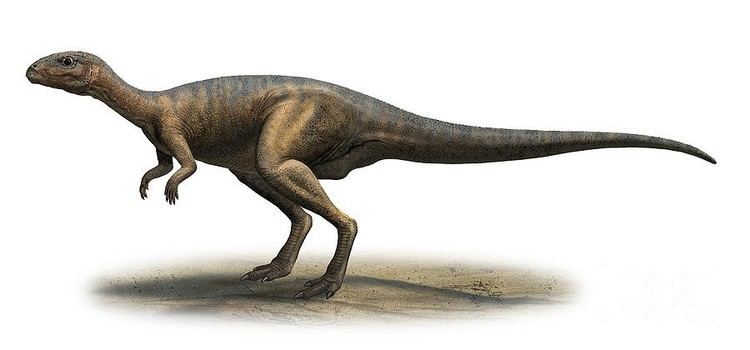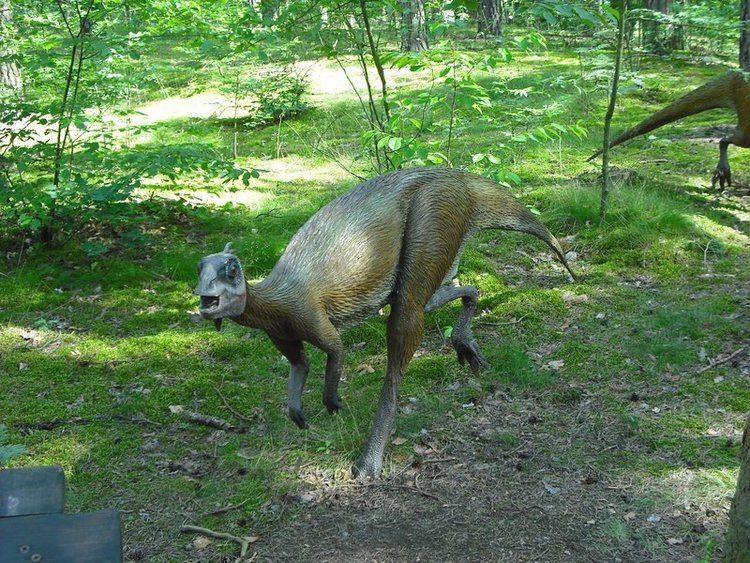Suborder †Ornithopoda Scientific name Dryosaurus Rank Genus | Phylum Chordata Higher classification Dryosauridae | |
 | ||
Similar | ||
I m a dinosaur dryosaurus hooplakidz tv
Dryosaurus (/ˌdraɪoʊˈsɔːrəs/ DRY-o-SAWR-əs; meaning 'tree lizard', Greek δρυς/drys meaning 'tree, oak' and σαυρος/sauros meaning 'lizard'; the name reflects the forested habitat, not a vague oak-leaf shape of its cheek teeth as is sometimes assumed) is a genus of an ornithopod dinosaur that lived in the Late Jurassic period. It was an iguanodont (formerly classified as a hypsilophodont). Fossils have been found in the western United States, and were first discovered in the late 19th century. Valdosaurus canaliculatus and Dysalotosaurus lettowvorbecki were both formerly considered to represent species of Dryosaurus.
Contents
- I m a dinosaur dryosaurus hooplakidz tv
- Dinosaur cartoons for children dryosaurus more learn dinosaur facts with i m a dinosaur
- DescriptionEdit
- Diet and dentitionEdit
- Growth and developmentEdit
- Discovery and namingEdit
- PaleoecologyEdit
- References

Dinosaur cartoons for children dryosaurus more learn dinosaur facts with i m a dinosaur
DescriptionEdit

Dryosaurus had a long neck, long, slender legs and a long, stiff tail. Its arms, however, with five fingers on each hand, were short. Known specimens were about 8 to 14 feet (2.4 to 4.3 m) long and weighed 170 to 200 pounds (77 to 91 kg). However, the adult size is unknown, as no known adult specimens of the genus have been found.

Dryosaurus had a horny beak and cheek teeth and, like other ornithopods, was a herbivore. Some scientists suggest that it had cheek-like structures to prevent the loss of food while the animal processed it in the mouth.
A quick and agile runner with strong legs, Dryosaurus used its stiff tail as a counterbalance. It probably relied on its speed as a main defense against carnivorous dinosaurs.
Diet and dentitionEdit
The teeth of Dryosaurus were, according to museum curator John Foster, characterized by "a strong median ridge on the lateral surface."Dryosaurus subsisted primarily on low growing vegetation in ancient floodplains.
Growth and developmentEdit
A Dryosaurus hatchling found at Dinosaur National Monument in Utah confirmed that Dryosaurus followed similar patterns of craniofacial development to other vertebrates; the eyes were proportionally large while young and the muzzle proportionally short. As the animal grew, its eyes became proportionally smaller and its snout proportionally longer.
Discovery and namingEdit
In 1876, Samuel Wendell Williston in Albany County, Wyoming discovered the remains of small euornithopods. In 1878, Professor Othniel Charles Marsh named these as a new species of Laosaurus, Laosaurus altus. The specific name altus, meaning "tall" in Latin, refers to it being larger than Laosaurus celer. In 1894, Marsh made the taxon a separate genus, Dryosaurus. The generic name is derived from the Greek δρῦς, drys, "tree, oak", referring to a presumed forest-dwelling life mode. Later it was often assumed to have been named after an oak-leaf shape of its cheek teeth, which, however, is absent. The type species remains Laosaurus altus, the combinatio nova is Dryosaurus altus.
The holotype, YPM 1876, was found in a layer of the Upper Brushy Basin Member of the Morrison Formation, dating from the Tithonian. It consists of a partial skeleton including a rather complete skull and lower jaws. Several other fossils from Wyoming have been referred to Dryosaurus altus. They include specimens YPM 1884: the rear half of a skeleton; AMNH 834: a partial skeleton lacking the skull from the Bone Cabin Quarry; and CM 1949: a rear half of a skeleton dug up in 1905 by William H. Utterback. From 1922 onwards in Utah, Earl Douglass discovered Dryosaurus remains at the Dinosaur National Monument. These include CM 11340: the front half of a skeleton of a very young individual; CM 3392: a skeleton with skull but lacking the tail; CM 11337: a fragmentary skeleton of a juvenile; and DNM 1016: a left ilium dug up by technician Jim Adams. Other fossils were found in Colorado. In Lily Park, Moffat County, James Leroy Kay and Albert C. Lloyd in 1955 recovered CM 21786, a skeleton lacking skull and neck. From 'Scheetz’ Quarry 1, at Uravan, Montrose County, in 1973 Peter Malcolm Galton and James Alvin Jensen described specimen BYU ESM-171R found by Rodney Dwayne Scheetz and consisting of some vertebrae, a left lower jaw, a left forelimb and two hindlimbs. Gregory S. Paul in 2010 suggested that the Utah material represented a separate species.
Apart from Dryosaurus altus, several other species have been named in the genus. The first of these was created accidentally when in 1903 Giuseppe de Stefano renamed Crocodilus phosphaticus Thomas 1893 into Dryosaurus phosphaticus; he had intended to call it Dyrosaurus phosphaticus. This was only emended by Éric Buffetaut in 1981.
PaleoecologyEdit
The Dryosaurus holotype specimen YPM 1876 was discovered in Reed’s YPM Quarry 5, in the Upper Brushy Basin Member, of the Morrison Formation. In the Late Jurassic Morrison formation of Western North America, Dryosaurus remains have been recovered from stratigraphic zones 2-6. A spectacular digsite near Uravan, Colorado held hundreds of D. altus fossils which represented multiple stages of the animal's life cycle. This formation is a sequence of shallow marine and alluvial sediments which, according to radiometric dating, ranges between 156.3 million years old (Ma) at its base, to 146.8 million years old at the top, which places it in the late Oxfordian, Kimmeridgian, and early Tithonian stages of the Late Jurassic period. In 1877 this formation became the center of the Bone Wars, a fossil-collecting rivalry between early paleontologists Othniel Charles Marsh and Edward Drinker Cope. The Morrison Formation is interpreted as a semiarid environment with distinct wet and dry seasons. The Morrison Basin where dinosaurs lived, stretched from New Mexico to Alberta and Saskatchewan, and was formed when the precursors to the Front Range of the Rocky Mountains started pushing up to the west. The deposits from their east-facing drainage basins were carried by streams and rivers and deposited in swampy lowlands, lakes, river channels and floodplains. This formation is similar in age to the Solnhofen Limestone Formation in Germany and the Tendaguru Formation in Tanzania.
The Morrison Formation records an environment and time dominated by gigantic sauropod dinosaurs such as Camarasaurus, Barosaurus, Diplodocus, Apatosaurus and Brachiosaurus. Dinosaurs that lived alongside Dryosaurus included the herbivorous ornithischians Camptosaurus, Stegosaurus and Othnielosaurus. Predators in this paleoenvironment included the theropods Saurophaganax, Torvosaurus, Ceratosaurus, Marshosaurus, Stokesosaurus, and Ornitholestes and Allosaurus, which accounting for 70 to 75% of theropod specimens and was at the top trophic level of the Morrison food web. Other vertebrates that shared this paleoenvironment included bivalves, snails, ray-finned fishes, frogs, salamanders, turtles, sphenodonts, lizards, terrestrial and aquatic crocodylomorphans, and several species of pterosaur. Early mammals were present in this region, such as docodonts, multituberculates, symmetrodonts, and triconodonts. The flora of the period has been revealed by fossils of green algae, fungi, mosses, horsetails, cycads, ginkgoes, and several families of conifers. Vegetation varied from river-lining forests of tree ferns, and ferns (gallery forests), to fern savannas with occasional trees such as the Araucaria-like conifer Brachyphyllum.
Other sites that have produced Dryosaurus material include Bone Cabin Quarry, the Red Fork of the Powder River in Wyoming and Lily Park in Colorado.
